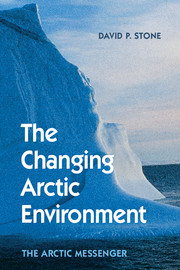Book contents
- Frontmatter
- Dedication
- Contents
- Acknowledgements
- Acronyms
- 1 Personal Beginnings
- PART I THE CHANGING ARCTIC
- PART II WORKING TOGETHER
- PART III WHAT IS THE PRESENT STATE OF KNOWLEDGE?
- 4 Radioactivity
- 5 Heroic Efforts
- 6 Acidification and Arctic Haze
- 7 Stratospheric Ozone Depletion
- 8 Persistent Organic Pollutants and Heavy Metals (Including Mercury)
- 9 Conducting Marine Science in the Arctic
- 10 Climate Change in the Arctic
- PART IV WHAT DOES ALL THIS MEAN?
- Appendix I The Intergovernmental Panel on Climate Change (IPCC)
- Appendix II What Will Happen in the Future If We Do Nothing or If We Try Very Hard to Aggressively Reduce GHG Emissions: Projected Change Under Different Emission Scenarios
- Appendix III Some Geophysical Background Notes Related to Climate and Weather
- Appendix IV Orbital Forcing
- Appendix V The Concept of Commitment
- Bibliography
- Credits
- Index
4 - Radioactivity
from PART III - WHAT IS THE PRESENT STATE OF KNOWLEDGE?
Published online by Cambridge University Press: 05 February 2015
- Frontmatter
- Dedication
- Contents
- Acknowledgements
- Acronyms
- 1 Personal Beginnings
- PART I THE CHANGING ARCTIC
- PART II WORKING TOGETHER
- PART III WHAT IS THE PRESENT STATE OF KNOWLEDGE?
- 4 Radioactivity
- 5 Heroic Efforts
- 6 Acidification and Arctic Haze
- 7 Stratospheric Ozone Depletion
- 8 Persistent Organic Pollutants and Heavy Metals (Including Mercury)
- 9 Conducting Marine Science in the Arctic
- 10 Climate Change in the Arctic
- PART IV WHAT DOES ALL THIS MEAN?
- Appendix I The Intergovernmental Panel on Climate Change (IPCC)
- Appendix II What Will Happen in the Future If We Do Nothing or If We Try Very Hard to Aggressively Reduce GHG Emissions: Projected Change Under Different Emission Scenarios
- Appendix III Some Geophysical Background Notes Related to Climate and Weather
- Appendix IV Orbital Forcing
- Appendix V The Concept of Commitment
- Bibliography
- Credits
- Index
Summary
Ophelia: “Rich gifts wax poor when givers prove unkind”.
William Shakespeare, HamletBefore starting to draft this chapter, I gave myself a short revision of school physics and chemistry. It could be useful to pass it on now to any reader whose memory is as poor as mine.
Fundamentals
The nucleus of every atom of an element has a fixed number of protons, which is equivalent to its atomic number. For example, the nuclei of hydrogen, helium, oxygen and uranium have 1, 2, 8, and 92 protons, respectively. Each proton carries a positive electric charge. Surrounding the nucleus are orbiting electrons, each of which carries a negative electric charge. Because the number of protons is nearly always equivalent to the number of electrons, the atom is neutral (carries neither a positive nor a negative charge). It is the number and arrangement of electrons (especially those in the outer orbits) that determine the chemical characteristics of the element.
In addition to its protons, the nucleus also contains neutrons. These have the same mass as the proton but do not carry an electric charge. Therefore, the same element can come in a number of different varieties depending on its total number of neutrons. These varieties are called isotopes or nuclides. There is a subtle difference in the definition of these two words, but we need not bother about it here. Isotopes (nuclides) of a substance are chemically identical but have a different mass. For example, uranium-238 (238U) has 92 protons and 146 neutrons, giving it an atomic mass of 238. Uranium-235 (235 U) has the same number of 92 protons but has 143 neutrons.
Some nuclides are stable, but others are said to be unstable because they constantly show a tendency to change (decay) into some- thing else, which may then itself also undergo further decay.
- Type
- Chapter
- Information
- The Changing Arctic EnvironmentThe Arctic Messenger, pp. 43 - 69Publisher: Cambridge University PressPrint publication year: 2015



